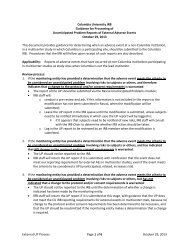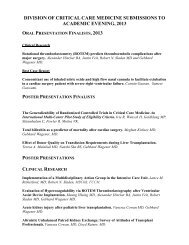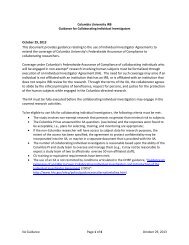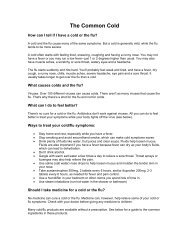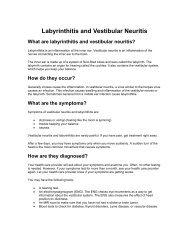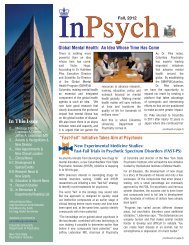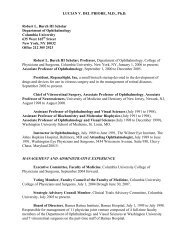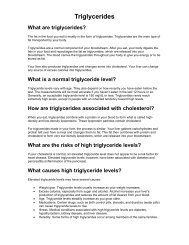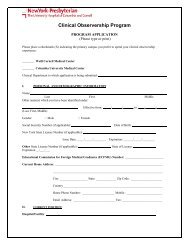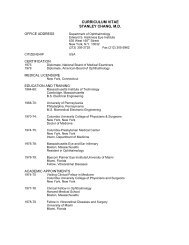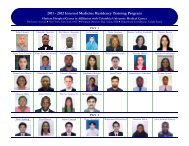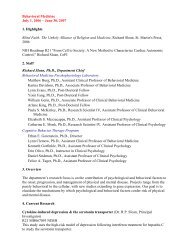news PS - Columbia University Medical Center
news PS - Columbia University Medical Center
news PS - Columbia University Medical Center
Create successful ePaper yourself
Turn your PDF publications into a flip-book with our unique Google optimized e-Paper software.
commercialize the trap would become, in Dr. Yancopoulos’ words, “at<br />
the time, one of the biggest deals in biotech history.”<br />
Regeneron has two FDA-approved products on the market, Eylea, a<br />
drug that effectively treats age-induced macular degeneration, and Arcalyst,<br />
a treatment for cryopyrin-associated periodic syndromes (CA<strong>PS</strong>), a<br />
rare hereditary condition in adults and children. Many more medicines are<br />
in the R&D pipeline at various stages of clinical trials. Dr. Yancopoulos is<br />
particularly proud that, in contrast to the industry norm, all of Regeneron’s<br />
approved and pipeline products were discovered and developed by Regeneron.<br />
Those products have made Regeneron one of the 10 largest biotech<br />
companies (in terms of market capitalization) in the world.<br />
Acorda’s history of drug development likewise hit bumps before<br />
rebounding. Initially focusing on spinal cord injury, the company invested<br />
tens of millions of dollars in its lead drug, Ampyra, which failed in<br />
phase 3 clinical trials. Dr. Cohen still believes “that some people with<br />
spinal cord injury might benefit from the drug, but we didn’t prove it in<br />
those trials.” Acorda also conducted phase 3 clinical trials on the same<br />
drug for patients with MS. Those trials too failed at first. “But after deep<br />
analysis, we realized that what failed was the way we analyzed it, that,<br />
in fact, the drug had worked beautifully in a sub-set of patients, about<br />
40 percent of whom had had a positive response, dramatically improving<br />
their walking ability. So we designed phase 3 trials to prove it, and we<br />
did.” The fruit of basic scientific research conducted at the <strong>University</strong> of<br />
‘ There is no absolute failure. Unless<br />
you keep trying you’re never going to<br />
come up with anything.’<br />
Chicago in the early 1980s, Ampyra was first licensed by another company<br />
before Dr. Cohen saw its potential and decided to bank on it. FDA<br />
approval finally came in 2010, almost 25 years after the drug’s discovery.<br />
Committed to Insight and Calculated Risk<br />
“If I had to start Acorda today, from exactly where I was in 1992 when I<br />
committed to it, I don’t believe there’s any way I would have succeeded,” says<br />
Dr. Cohen. “I don’t believe this drug would have seen the light of day because<br />
it would have been impossible to keep investors interested long enough.”<br />
Dr. Yancopoulos concurs with the sentiment. “It helps to have been a<br />
little naïve. Because if you had told me it was going to take 22 years to<br />
succeed, if I had known all the risks back when I started out, that we had<br />
a significant chance of going out of business several times over the years,<br />
honestly I probably wouldn’t have done this.”<br />
But for Drs. Cohen, Maddon, and Yancopoulos, and like-minded medical<br />
entrepreneurs, it’s all about toying with the seemingly impossible and<br />
turning virtual failure into success.<br />
“Ron had the insight,” Dr. Maddon points out, “and he was willing to<br />
take the risk to license a product others had dropped. To someone else<br />
that drug may have been a dog, but to Ron it was a gem in the rough.<br />
Each of us is committed to insight. Each of us is willing to take risk. And<br />
each of us has developed a thick skin and is willing to risk failure.”<br />
“There is no absolute failure,” Dr. Yancopoulos qualifies his friend’s<br />
insight. “With every setback, you adapt, you figure out how to make it<br />
work, and make something great out of it. And unless you keep trying<br />
you’re never going to come up with anything.”<br />
The Beauty of Brainstorming<br />
Gregarious by nature, the three entrepreneurs all agree that gathering<br />
good people and working together in a team is the key to their success<br />
and also a lot of fun.<br />
“I think I’ve sort of figured out over the years how to bring a group<br />
of the right people together in a room,” says Dr. Yancopoulos. “Make<br />
sure the computers and the iPhones are switched off, and just brainstorm<br />
together. If you’re lucky, every now and then, you hit that aha! moment<br />
that makes it all worthwhile.”<br />
“Some of my favorite moments in this whole process,” Dr. Cohen<br />
agrees, “happen when getting together with my chief scientific officer and<br />
other team members, looking at data or thinking about data or challenging<br />
each other. We’ll be talking when all of a sudden it’s: Oh, my gosh!<br />
We’ve found the right analysis, the right direction.”<br />
“No question about it,” Dr. Maddon adds, “as Ron just said, one of<br />
the greatest joys and the greatest privileges is surrounding ourselves with<br />
amazing people. They stoke the creativity, the innovation, because one<br />
person, however insightful he may be, cannot sustain a company.”<br />
Yet while all three learned to treasure teamwork from working for and<br />
with revered mentors at P&S and, in Dr. Cohen’s case, the <strong>University</strong> of<br />
Virginia as well, they fault America’s top medical schools for, at best,<br />
turning a blind eye to the possibilities of biotech and other medically<br />
related business ventures and, at worst, discouraging their graduates<br />
from pursuing that option.<br />
Bucking the Academic Bias<br />
“Much as I revere P&S and am profoundly grateful for the solid grounding<br />
I got there in medicine,” Dr. Cohen maintains, “I would say that the three<br />
of us did what we did, not because of how we were pushed at <strong>Columbia</strong>,<br />
but in spite of the biases that we encountered there. There is an ethos in the<br />
academy that says: What we do here is pure, this is real science, and the<br />
stuff that goes on in industry is tainted, it’s bad, it’s led by the profit motive.<br />
The time has long passed for that attitude to change.” Dr. Cohen believes it<br />
is imperative for P&S and peer institutions to incorporate course material<br />
that exposes entrepreneurially minded medical students to the possibility<br />
of applying their knowledge to industry. “We in industry often rely on the<br />
insights generated in the academy. But there is no way to turn those insights<br />
into new medicine unless you integrate industry.”<br />
“I couldn’t agree more with Ron,” says Dr. Yancopoulos, who favors<br />
the establishment of a guest lectureship on medicine and business at P&S.<br />
(The “Pam and Mark Grodman’77 Joint Degree Program Fund,” recently<br />
established by another MD entrepreneur, Marc Grodman’77, CEO of<br />
BioReference Laboratories, will start the ball rolling.) “P&S graduates<br />
who go into business,” adds Dr. Yancopoulos, “have a different kind of<br />
drive, a different tolerance of risk. Clearly not all medical students will be<br />
so inclined, but there may be a few who have this ability and this interest<br />
and this daring, who may not even know that the possibility exists.”<br />
Spring 2012 <strong>Columbia</strong>Medicine 39



